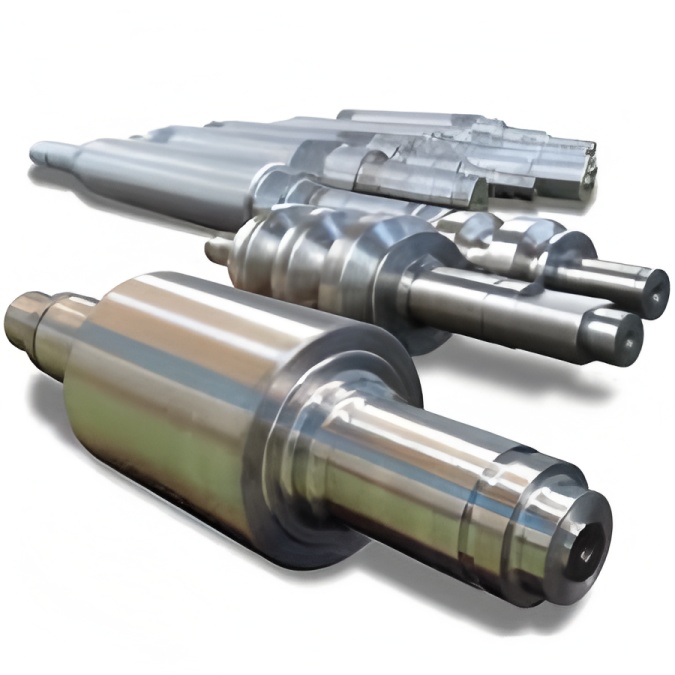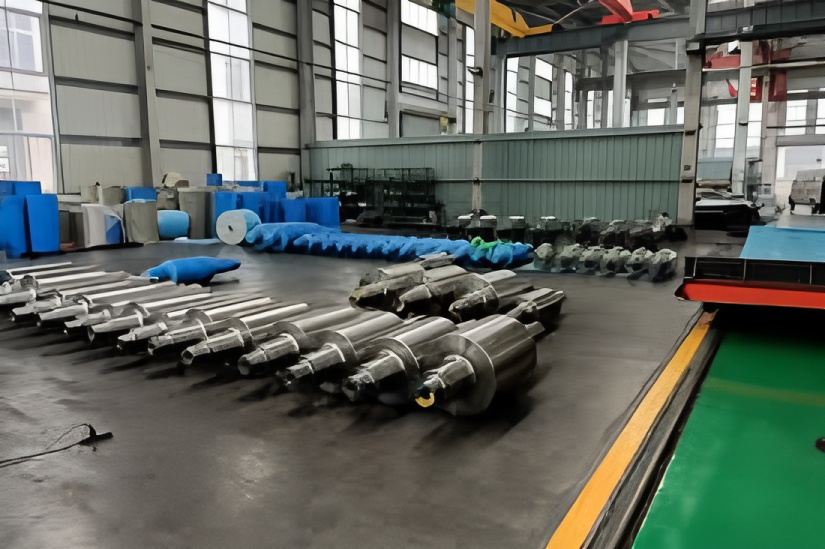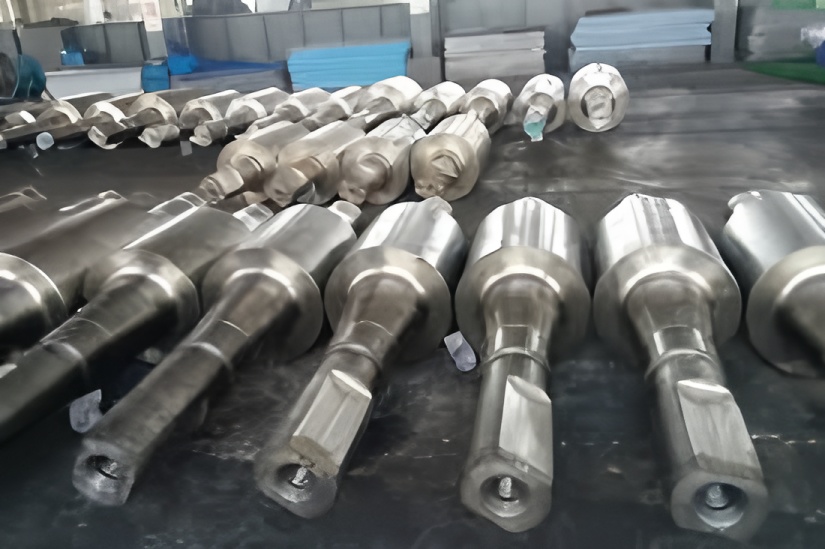Slitting Knife Steel Sticking
Steel sticking on the slitting knife refers to the phenomenon where slag adheres to one or both sides of the slitting knife during the slitting and rolling process, eventually leading to slitting failure. The main causes of slitting knife steel sticking are as follows:
Excessive Rolling Temperature: If the initial temperature is too high, during the cutting process in the finishing rolling zone, significant reduction of the cutting wedge generates excessive heat due to severe deformation. This causes a rapid rise in local metal temperature and irregular shape of the slit strip, resulting in steel sticking on the slitting knife.
Incorrect Incoming Material Size: Slitting and rolling follow the axe principle, where the incoming material must match the angle of the 16-frame slitting wedge. If the material size is too large or too small, cutting becomes difficult, leading to excessively large slit strips. As the rolling piece advances, friction between the slit strip and the slitting knife causes steel sticking.
Misalignment of Slitting Wheel or Rolling Groove: The splitting guide guard must be installed to ensure the splitting wedge, splitting wheel, and splitting knife are aligned in a straight line. Improper installation causes misalignment between the material and the cutting wheel, resulting in off-track cutting, oversized slit strips, and friction-induced steel sticking.
Inadequate Cooling of Slitting Knife: The slitting guide must ensure sufficient cooling, especially for the slitting knife. During normal production, billet and rolling groove wear can cause small oxide scales on the rolling piece surface and irregular slit strip shapes. Friction with the slitting knife leads to slag adhesion on both sides. Poor cooling exacerbates this issue, eventually causing guide pile steel rush-out and downstream mill adjustment failure.
Incorrect Slitting Knife Spacing: After the rolling piece enters the slitting box, it moves at a certain angle. If the slitting knife spacing is improperly set, the rolling piece rubs against the slitting knife, causing steel sticking.
Unreasonable Splitting Hole Design: The design of the 15-16 frame hole pattern system is critical, and the splitting angle design must match accordingly.
Poor Rolling Mill Rigidity: Insufficient mill rigidity, excessive bouncing, and poor material shape control contribute to the issue.
Inappropriate Slitting Knife Length: This is more evident in three slitting. If the knife is too close to the slitting wheel, slag discharge becomes inconvenient, leading to steel sticking.
Unreasonable Splitting Wheel Angle Design: Improper splitting wheel angle design results in unsmooth splitting.
Poor Shape Control in Racks 12-18: Inadequate control causes material twisting, oversized or undersized dimensions, and head/tail largeness, leading to sticking and rigidity issues.
Billet Quality Issues: Billets containing air bubbles and blooms can cause problems.
Aging or Groove Jumping in Key Train Rolling Groove: Worn or misaligned rolling grooves in key trains contribute to the issue.
Misalignment of Guide Beam and Guard: Improper alignment with the rolling center causes problems.
Poor Tension Control or Unstable Temperature: Inconsistent tension across flights or unstable temperature affects the process.
Excessive Wear of Guide Plate or Faulty Guide Groove Assembly: Worn guide plates or faulty assemblies contribute to the issue.
Solutions for Slitting Knife Steel Sticking
Control steel temperature according to process requirements. When the main motor load is satisfied, maintain the temperature between 1000–1050°C, preferably not exceeding 1100°C.
Strictly control material dimensions as per process requirements. Ensure dimensional deviations are within ±0.5 mm for rough rolling six stands, ±0.3 mm for medium rolling, and 0.2 mm for finish rolling. Pre-cutting and cutting sorts must strictly follow technological requirements to ensure the fullness of split sorties.
Install the slitting guide accurately, ensuring the slitting knife, slitting wheel, and slitting groove are in a straight line. Strengthen cooling for the slitting guide and rolling groove, and promptly observe the material’s turning degree. Designers must thoroughly proofread the hole pattern design.
Ensure proper slitting knife spacing and carefully check its appropriateness.
Control the material shape of each pass as required.
Conduct timely online inspections of the rolling line. Correctly install the guide guard and guide guard beam.
Address issues related to the splitting wheel and guide guard design.
Optimize the splitting wheel angle for smooth splitting.
Improve material shape control for racks 12–18 to prevent twisting and dimensional irregularities.
Ensure billet quality by addressing air bubbles and blooms.
Regularly inspect and maintain key train rolling grooves to prevent aging or misalignment.
Align the guide beam and guard with the rolling center.
Stabilize tension control and temperature across all flights.
Replace excessively worn guide plates and ensure proper guide groove assembly.
The Issue of Four-Line Difference in Slitting Rolling
Although the slitting rolling process improves operational rates and significantly increases output, it is affected by factors such as steel temperature fluctuations, rolling groove wear, pass system design, guide and guard installation, and rolling groove processing accuracy. These factors cause variations in the dimensions of the parts, known as line difference. To achieve higher economic benefits while maintaining steel quality, measures must be taken to minimize this gap. The main reasons for line difference are:
Misaligned Imported Guide Guards: If the imported guide guards for pre-cutting 15 racks or cutting 16 racks are misaligned with the rolling line, the biased side will have a larger cross-sectional area after cutting, resulting in larger finished product dimensions.
Inconsistent Hole Type Wear: Uneven cooling of the rolling groove, irregular shape of the previous pass, or improper guide and guard design can cause inconsistent wear, leading to variations in the cross-sectional area and finished product size.
Inconsistent Roll Gap on Both Sides: During roll-changing adjustments, inconsistent roll gap control on both sides of the 15–18 racks results in larger hole areas on the side with a larger roll gap, causing differences in the finished product.
Low Processing Precision of Rolling Groove: This is mainly related to the roll material, wear and repair accuracy of forming tools in the repair workshop, and processing methods.
Poor Material Shape Control in Racks 12–16: Slitting production heavily relies on the matching of racks 12–16. Poor matching leads to line difference.
Key Factors: Line differences are generally concentrated on aging K4 rolling grooves, alignment issues with K3K4 guides and guards, and K6 material shape changes.
Solutions for Four-Line Difference
Install guides and guards accurately. Pre-adjust them before changing rolls to ensure all positions are aligned and fixed.
Improve cooling water pipes for racks 15 and 16, enhance cooling effects, and conduct spot checks during production.
When changing rolls, start the rolling mill and measure the roll gap on both sides using the same welding rod, controlling the deviation within 0.1 mm.
Improve roll materials by using high-speed steel rolls for racks 15, 17, and 18. Collaborate with the processing department to enhance processing accuracy.
Strictly control the shape of each pass according to process requirements. Adjust guide and guard gaps using sample bars as required.
18-Rack Top Exit Failure
During slitting and rolling production, top exit failure at the 18th stand is common and is a major issue restricting four-slit production. It mainly manifests as severe bending of the inner or outer two-wire steel front end in the direction of the slitting belt, detachment of the pipe tongue tip, or 180-degree bending causing the steel to rush out from the exit and get stuck in the guide groove, leading to pile-up. The main reasons for this phenomenon are:
Pass Design Defects: Issues in parameter allocation during pass design make adjustments difficult and require high employee skill and operational levels.
Oversized 17-Frame Hole Shape Groove: An improperly designed groove fails to process the slitting belt effectively.
Inaccurate Material Shape Control: Underfilled 15 racks or oversized 16 racks cause severe asymmetry in the two-line front ends after cutting. Uneven deformation in the 17 racks results in poorly processed slitting belts, leading to ejection when entering the 18 racks. Alternatively, oversized 12–16 racks cause severe and uneven deformation in the 18 racks, resulting in ejection.
Improper Guide and Guard Clearance for 15 and 16 Racks: Poor neutrality causes the rolling piece front end to bend and cut off during slitting, leading to oversized or undersized head dimensions. This results in top exit failure at the 18 racks after passing through the 17 racks.
High Temperature at Slitting Belt: Elevated temperatures make it difficult for the slitting belt to exit the groove on the 18 racks.
Guide Guard Design Issues or Oversized Outlet Cavity of 18 Racks: An oversized cavity positioned too far from the roll fails to prevent head shape changes in the 18 racks effectively.
Improper Assembly and Alignment of 18 Rolling Mill Guide Guards and Beams: Misalignment during assembly causes issues.
Poor Matching of 17-Frame Material Shape with Imported Guide Plate: Incompatibility between the material shape and guide plate leads to problems.
Incorrect Assembly of Splitting Guide Guard or Splitting Wheel: Eccentric direction or non-uniformity in the splitting wheel causes issues.
Steel Transfer Issues Between Previous Sorties: Particularly between racks 12–13.
Improper Torsion Angle Adjustment at 17-Frame Exit: Incorrect adjustment affects the process.
Severe Rolling Groove Wear: Worn grooves contribute to the problem.
Splitting Wheel and Splitting Guide Guard Design Issues: Flaws in design cause operational failures.
Excessive Connecting Shaft Gap: Large gaps lead to misalignment and failures.
Solutions for 18-Rack Top Exit Failure
Optimize the pass system and redistribute the reduction for each pass. Establish a definitive production process.
Explore the best technology, focusing on heating parameters, dimensions of each rack, speed, and current parameters. Strictly implement standardized practices across all teams.
Improve the assembly level of rolling mill guides and guards, with emphasis on finishing mill 15–16. Ensure mill rigidity and axial stability. Strictly perform pre-adjustment and installation of guides and guards.
Implement targeted cooling for the slitting belt.
Improve the design of 18-guide guards and the inner cavity size, controlling them within a specific range. Ensure the tongue tip is as close as possible to the deformation zone to enhance guidance.
Follow these principles for 17-rack material shape and imported guide plate installation:
When the 17-rack hole pattern is underfilled, the guide plate should not deviate toward the cutting belt.
When the 17-rack hole pattern is full, the guide plate should deflect in the opposite direction of the slitting belt.
Regularly inspect roll wear.
Modify the form of guidance and guarding.



